Evaporation In Pharmaceutical Engineering Introduction
Evaporation is the process of a substance in a liquid state changing to a gaseous state due to an increase in temperature and or pressure.
Or
Evaporation is a process in which large quantities of liquid are vaporized to get a concentrated product by applying heat.
- Evaporation is a type of vapourization that occurs on the surface of a liquid as it changes into the gaseous phase.
- The surrounding gas must not be saturated with the evaporating substance.
- When the molecules of the liquid collide, they transfer energy to each other based on how they collide.
- When a molecule near the surface absorbs enough energy to overcome the vapour pressure, it will “escape” and enter the surrounding air as a gas.
- When evaporation occurs, the energy removed from the vaporized liquid will reduce the temperature of the liquid, resulting in evaporative cooling.
- Either suspension or solutions can be subjected to evaporation.
- The only condition is that the liquid must be volatile and the solute must be nonvolatile. Since heat is supplied the constituents must be thermo-stable.
Evaporation In Pharmaceutical Engineering Objectives
- One of the primary objectives of this evaporation is to reduce the volume of the product by some significant amount without loss of nutrient components.
- To make transport and storage easier as evaporation decreases the weight and volume of the product.
- To remove large amounts of liquid from the product before the dehydration process.
- To improve the stability of the product.
Evaporation Applications In Pharmaceutical Engineering
- Manufacture of bulk drugs: The evaporation process is used in the manufacture of bulk drugs in pharmaceutical industries.
- It is also used in the formulation of biological products like enzymes, antibiotics, vitamins etc.
- In demineralization of water.
- Film deposition: Thin films may be deposited by evaporating a condensing it onto a substrate, or by dissolving the substance in a so vent, spreading the resulting solution thinly over a substrate and evaporating the solvent,
- Industrial applications include many printing and coating processes, recovering s<a\U from solutions.
- Concentration of blood plasma and serum.
- Removal of water and solvent from fermentation broths.
- Concentration of herbal extract.
Factors Influencing The Rate Of Evaporation In Pharmaceutical Engineering
1. Temperature:
- Temperature is directly proportional to the rate of evaporation. Increase in temperature increases the rate of evaporation.
- At a given temperature some molecules possess more kinetic energy than the other molecules. Fast-moving molecules will move from the surface to the vapour state.
- While the molecules having less kinetic energy will remain in the bulk of the liquid.
- If the temperature is increased the molecules will get more energy and they will escape from the surface of the liquid.
2. Vapour pressure:
- The rate is directly proportional to the vapour pressure of the liquid. If the vapour pressure of the liquid is more then the rate of evaporation will be more.
- The lower the external pressure the lower the boiling point of liquid and hence greater will be the evaporation.
- This condition is achieved by using a vacuum. Saturation of the overhead space with vapours of liquid decreases the evaporation rate.
- If the air already has a high concentration of the substance evaporating, then the given substance will evaporate more slowly.
3. Flow rate of air:
- This is in part related to the concentration points above.
- If “fresh” air (i.e., air which is neither already saturated with the substance nor with other substances) is moving over the substance all the time, then the concentration of the substance in the air is less likely to go up with time, thus encouraging faster evaporation.
- This is the result of the boundary layer at the evaporation surface decreasing with flow velocity, decreasing the diffusion distance in the stagnant layer.
5. Inter-molecular forces:
- The stronger the forces keeping the molecules together in the liquid state, the more energy one must get to escape.
- This is characterized by the enthalpy of vapourization.
- So stronger intermolecular forces will require high energy to evaporate the molecules. So the rate of evaporation will get decreased
6. Surface area:
A substance that has a larger surface area will evaporate faster, as there are molecules per unit of volume that are potentially able to escape. are more surface
7. Type of product required:
- The type of product which has to be evaporated decides the method of evaporation equipment for evaporation.
- This affects not only the rate of evaporation but also the quality of the final product, For example, an Open pan produces liquid or dry concentrate, which.
- The vacuum as well as the evaporator give the porous product.
8. Film and deposits:
- Some products during concentration form a film on the surface of the liquid.
- This film formed reduces the evaporating surface and precipitated matter (on the surface) hinders the transfer of heat.
- This can be avoided by stirring.
Differences Between Evaporation And Other Heat Processes In Pharmaceutical Engineering
1. Difference between Evaporation and Distillation:
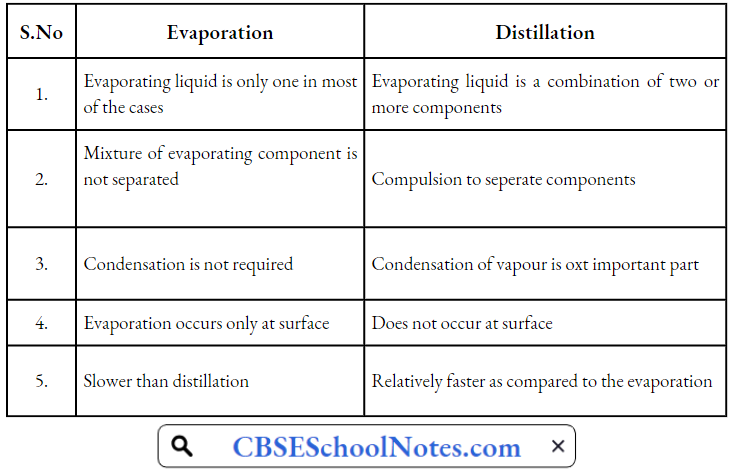
2. Difference between Evaporation and Sublimation:

3. Difference between Evaporation and Boiling:
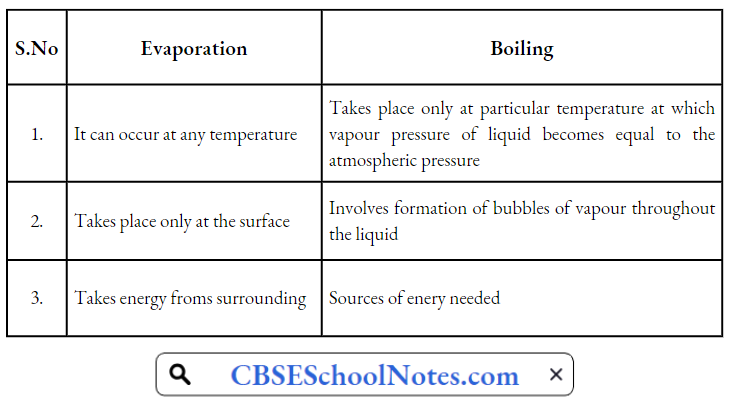
4. Difference between Evaporation and Drying
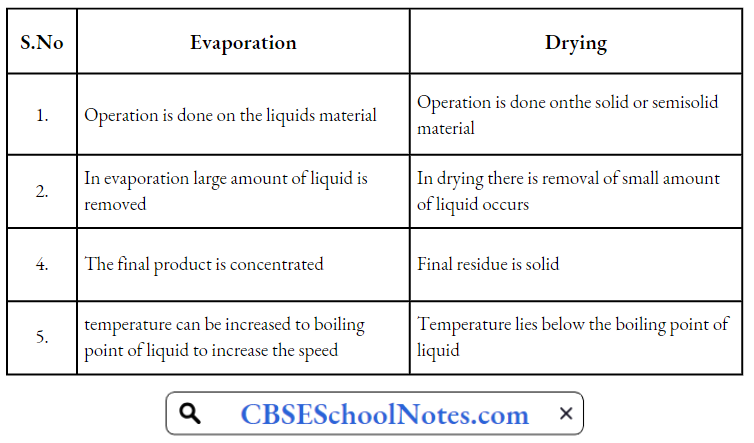
5. Difference between Evaporation and Crystallization:
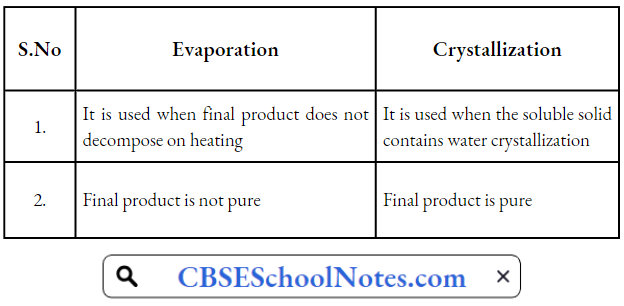
Equipment Used For Evaporation In Pharmaceutical Engineering
The equipment used for evaporation is called as evaporator.
They are classified as follows:
1. Evaporator with the heating medium in the jacket
Example: Evaporating pan
2. Vapour-heated evaporators with tubular heating surfaces
1. Evaporators with tubes placed horizontally
Example: Horizontal tube evaporator
2. Evaporators with tubes placed vertically
- Evaporators with short tubes
- Single effect evaporators
- Example: Short tube vertical evaporator
- Multiple effect evaporator
- Example: Triple effect evaporator
- Single effect evaporators
- Evaporators with long tubes
- Evaporators with natural circulation
- Example: Climbing film evaporator (Rising film evaporator}
- Evaporators with forced circulation
- Example: Forced circulation evaporator
- Evaporators with natural circulation
Steam Jacketed Kettle (Evaporating Pan) In Pharmaceutical Engineering
Evaporating pans or steam-jacketed kettles come under the classification of natural circulation evaporators.
It. consists of a hemispherical pan surrounded by a steam jacket. The hemispherical shape provides a large surface area for evaporation. The evaporation pan may be fixed and the emptying of the pan can be done from the product outlet.
Steam-jacketed kettles Principle:
The conduction and convection mechanism is involved in the evaporation process. So that the heat is transferred by this mechanism to the material placed for evaporation in the pan. Steam provides heat to the pan in which the material is placed. The temperature rises and the escaping tendency of the solvent molecules into the vapour increases and enhances the vapourization of the solvent molecules.
Steam-jacketed kettles Construction:
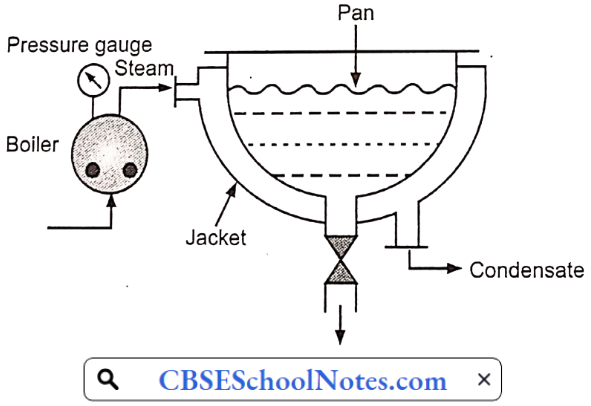
The construction of the steam-jacketed kettle or evaporating pan consists of two hemispherical pans one is the kettle (inner pan) and the other is called the jacket (outer).
- These two pans are joined to each other enclosing a space through which steam is passed. Several metals are used as materials for the construction of the kettle.
- Copper is an excellent material but it gets dissolved in acidic liquids to solve this problem tinned copper is used. Iron is used for the construction of the jacket because it has minimum conductivity.
- At the top of the jacket inlet for steam is provided.
- The jacket has two outlets one is for uncondensed gases (on the opposite side of the inlet) and another is to remove condensate (at the bottom of the jacket).
- The kettle is provided with one outlet for the product discharge at its bottom.
Steam-jacketed kettles Working:
The liquid to be evaporated is poured into a kettle. Steam is provided from the steam inlet of the jacket. This steam increases the temperature of the liquid. The condensed steam is removed from the outlet at the bottom of the jacket. The continuous stirring is essential.
To remove vapour to prevent condensation of liquid litres and also to accelerate the rate of evaporation fans are fitted. A kettle of capacity up to about 90 litres may be made to tilt. The concentrated product is collected from the outlet of the kettle at the bottom.
Steam-jacketed kettles Uses:
- An evaporating pan or steam-jacketed kettle is suitable for concentrating aqueous liquids.
- An evaporating pan or steam-jacketed kettle is suitable for concentrating thermo-stable liquors such as liquorice extracts.
Steam-jacketed kettles Advantages:
- Evaporating pan or steam-jacketed kettle is constructed both for small scale and large scale batch operations.
- Evaporating pan or steam-jacketed kettle is simple in construction and easy to operate, clean and maintain.
- Its cost of installation and maintenance is low.
- For the construction of the evaporating pan. materials such as copper, stainless steel aluminium and so on a wide variety of materials can be used.
- Stirring of the contents or materials and removal of the products is easy.
Steam-jacketed kettles Disadvantages:
- Decomposition of the product occurs which gets deposited at the bottom.
- The heating surface is limited and decreases proportionally to increase in the size of the pan.
- It is not suitable for the concentration of thermo-labile materials because the liquid is heated throughout in an open atmosphere. Further, there is evaporate under a reduced pressure
- The evaporating pan cannot be used
- For the evaporation of thermo-labelile pharmaceutical materials which are dissolved in an organic solvent, such as ethyl alcohol, as there is no provision to recollect the costly organic solvents.
Horizontal Tube Evaporator In Pharmaceutical Engineering
Horizontal Tube Evaporator Principle:
In this type of evaporator, the steam is passed through the horizontal tubes. These tubes are immersed in a liquid to be evaporated. Heat transfer takes place through the tubes and the liquid outside the tubes gets heated. These heated tubes provide heat to the liquid. The Iquid gets evaporated. The concentrated liquid is collected from the bottom.
Horizontal Tube Evaporator Construction:
It consists of a cylindrical body. The lower body ring is provided with a steam compartment closed on the outside with cover plates and inside by tube sheets. Between the tube sheets, several horizontal tubes is fastened. There are outlets for non-condensed gases and condensed steam. Feed enters at a convenient point and thick liquor is collected at the bottom.
The evaporator is usually made of cast iron. The average size of the body is 6 to 8 ft. in diameter- and 8 to 12 ft in height. The tube tank is shallower and its width is around half the diameter of the body.
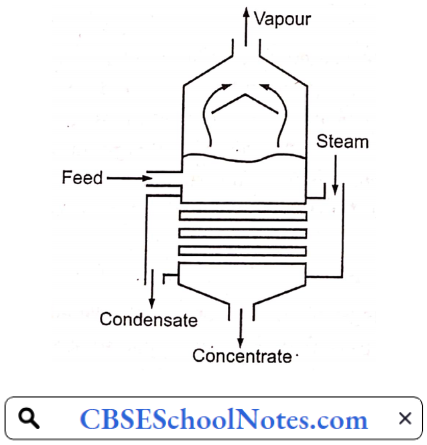
The liquor level is carried slightly above the tubes. The babes are attached in a typical manner. A thick tube sheet is used, holes are bored a little larger in diameter than the diameter of the tubes and conical rubber gaskets are slipped into the tubes;o that tubes fit into the tube sheet.
Each set of 4 tubes is secured by drawing down a packing pate-held in place by a nut. Such an arrangement facilitates the removal of tubes. Tubes are long enough to project about 1/2″ beyond the tube sheet at either end
Horizontal Tube Evaporator Working:
Feed is introduced into the evaporator until the tubes are immersed. Steam is introduced into the steam compartment. Tubes receive heat from steam and conduct it to liquid. Steam condensate passes through the corresponding outlet. Feed receives heat and solvent gets evaporated. Vapour escapes through the outlet placed on the top. This process is continued until a thick liquid is formed which is collected from the outlet at the bottom.
Horizontal Tube Evaporator Use:
It is used for non-viscous solutions that do not deposit crystals on evaporation.
Horizontal Tube Evaporator Advantages:
- The cost of per square meter of heating surface is less in horizontal tube evaporator.
- It provides a more heating surface for evaporation.
- It requires less space for installation.
- It is cheap.
Horizontal Tube Evaporator Disadvantages:
- Liquid circulation is poor in this evaporator.
- The formation of a semisolid layer on the evaporating surface reduces heat transfer rates.
- Not suitable for viscous liquids.
Climbing Film Evaporator In Pharmaceutical Engineering
In a typical climbing film evaporator, the heat exchanger is mounted vertically and the evaporator liquid flows in an upward direction through the tubes. Water in the ev<iporator liquid boils as the liquid rises in the tubes. This boiling action helps force liquid up and out of the tubes. The liquid and vapour leave the heat exchanger together and enter the vapour body. After vapour separation, the evaporator liquid flows from the vapour body through the circulating pump to the heat exchanger.
Climbing film evaporator Principle:
In this evaporator, tubes are heated externally using steam. The liquid is to be evaporated is heated before entering these tubes. The liquid is then allowed to flow through these heated tubes. The liquid near the walls of heated tubes starts to evaporate by forming bubbles. These bubbles fuse and form larger bubbles, which travel up in the tubes. The liquid films are blown up from the top of the tubes and the strike entrainment separator (deflector) is kept above. This throws the liquid concentrate down into the lower part from where it is withdrawn.
Climbing film evaporator Construction:
In this evaporator, the heating unit consists of steam-jacketed tubes. Here, the tubes are held between two plates. An entrainment separator is placed at the top of the vapour head. The evaporator carries a steam inlet, vent outlet and condensate outlet. The feed inlet is from the bottom of the steam compartment

Climbing film evaporator Working:
The preheated liquid feed is entered from the bottom of the evaporator. Steam into the spaces around the tubes through the inlet. The temperature of the liquid increases due to the heated walls of the tubes. The liquid starts to evaporate as its temperature go on increasing.
The evaporated part of the liquid forms small bubbles. These bubbles unite to form bubbles of size equal to the size of the width of the tubes. These bubbles trap a part of the liquid (slug) when going upward through the tubes. As more vapour is formed, the slug of liquid is blown up in the tubes facilitating the liquid to spread as a film over the walls.
This film of liquid continues to vaporize rapidly. Finally, the mixture of liquid concentrate and vapour is ejected at a high velocity from the top of the tubes. The entrainment separator prevents entrainment as well as it breaks the foam. The vapour leaves from the top, while the concentrate is collected from the bottom.
Climbing film evaporator Uses:
- Using climbing film evaporator, thermo labile substances such as insulin, liver extracts and vitamins can be concentrated.
- Clear liquids, foaming liquids and corrosive solutions in large quantities can be operated.
- Deposit of scales can be removed quickly by increasing the feed rate or reducing the steam rate so that the product is unsaturated for a short time.
Climbing film evaporator Advantages:
- Long and narrow tubes provide a large surface area.
- Very high film velocity reduces boundary layers to a minimum giving improved heat transfer.
- The contact time between the liquid and the heating surface is very short. So, it is suitable for heat-sensitive materials.
- Unlike short tube evaporators, the tubes not submerged. So there is no elevation of boiling point due to hydrostatic head.
- It is suitable for foam-forming liquids because foam can be broken by an are entrainment separator.
Climbing film evaporator Disadvantages:
- Climbing film evaporator is expensive.
- Construction is quite complicated.
- It is difficult to clean and maintain.
- It is not advisable for very viscous liquids.
Forced Circulation Evaporator In Pharmaceutical Engineering
Forced Circulation Evaporator Principle
In a forced circulation evaporator, the liquid is circulated through the tubes at high pressure using a pump. Hence boiling does not take place because the boiling point is elevated. Forced circulation of the liquids also creates some form of agitation. When the liquid leaves the tubes and enters the vapour head, the pressure falls suddenly. This lead to the flashing of super-heated liquor. Thus evaporation is affected.
Forced Circulation Evaporator Construction and Working:
Any evaporator that uses a pump to ensure higher circulation velocity is called a forced circulation evaporator. Forced circulation evaporators are used if boiling of the product on the heating surfaces is to be avoided due to the fouling characteristics of the product, or to avoid crystallization. The flow velocity in the tubes must be high, and high-capacity pumps are required.
The liquid is typically heated only a few degrees for each pass through the heat exchanger, which means the recirculation flow rate has to be high. This type of evaporator is also used in crystallizing applications because no evaporation, and therefore no concentration increase, takes place on the heat transfer surface.
Evaporation occurs as the liquid is flash-evaporated in the separator/flash vessel. In’ crystallizer applications this is then where the crystals form, and special separator designs are used to separate crystals from the recirculated crystal slurry. The heat exchanger (in evaporator parlance sometimes called the “calandria”) can be arranged either horizontally or vertically depending on the specific requirements in each case

Forced Circulation Evaporator Uses:
- If evaporation is conducted under reduced pressure, a forced circulation evaporator is suitable for thermo-labile substances.
- This method is used for the concentration of insulin and liver extracts.
- It is well suited for crystallizing operations where crystals are to be suspended at all times.
Forced Circulation Evaporator Advantages:
- In a forced circulation evaporator, there is rapid liquid movement due to a high heat transfer coefficient.
- Salting, scaling and fouling are not possible due to forced circulation.
- This evaporator is suitable for labile substances because of rapid evaporation.
- It is suitable for viscous preparation because a pumping mechanism is used.
Forced Circulation Evaporator Disadvantages:
- In a forced circulation evaporator the hold-up of liquids is high.
- The equipment is expensive because the power is required for the circulation of the liquids.
Multiple Effect Evaporator In Pharmaceutical Engineering
In single effect evaporator steam is used to heat the liquid which provides the latent heat ‘ of vapourization. The vapours are condensed in the condenser where the latent is given up to the cooling water and goes to waste.
To avoid this wastage two evaporators are connected with the piping arrangement so that the vapour from the calandria of the first effect is used to heat the calandria of the second effect. This means that the calandria of the second effect is used as a condenser for the first time.
So that the latent heat of vapourization is used to evaporate more quantity of the liquid instead of its going to waste. The vapour from the second effect is then taken to a condenser and converted into liquids. In general, not more than two or three effects are combined to have economical and efficient evaporation of liquids
Different types of feed arrangement of multiple effect evaporators:
1. Forward feed arrangement:
In this arrangement, the feed and steam introduced in the first effect and pressure in the first effect is highest and pressure in the last effect is minimum, so transfer of feed from one effect to another can be done without a pump.

2. Backward feed arrangement:
In this arrangement, feed is introduced in the last effect and steam is introduced in the first effect. For the transfer of feed, it requires a pump since the flow is from low pressure to higher pressure. Concentrated liquid is obtained in the first effect.

3. Mixed feed arrangement:
In this arrangement, feed is introduced in intermediate effect, flows in forward feed to the end of the series and is then pumped back to the first effect for final concentration. This permits the final evaporation to be done at the highest temperature.

Multiple Effect Evaporation In Pharmaceutical Engineering
Multiple Effect Evaporation Principle:
When the evaporator is fed with steam it boils the water present as feed. The water vapour produced has a large amount of heat which will go to waste if it is condensed. Therefore, in such case, evaporator makes very poor use of steam. The vapour used is suitable for passing to the calendria of the second evaporator where it is used as a heating medium.
If an evaporator is fed with steam at 126°C and it is evaporating water at 100°C then the water vapours coming off will also be at the temperature of 100° C and if these vapours are being used as the heating medium, water inside should boil at a lower temperature to maintain the temperature gradient for heat transfer. For this purpose vacuum should be drawn in the second evaporator to reduce the boiling point of water.
Multiple Effect Evaporation Construction:
The construction uses 3 evaporators i.e. Triple effect evaporator. The other aspects of the construction of the vertical tube evaporator remain the same. Vapour from first evaporator serves as the heating medium for the second and that from the second serves as a heating medium for the third evaporator. The last evaporator is connected to a vacuum pump
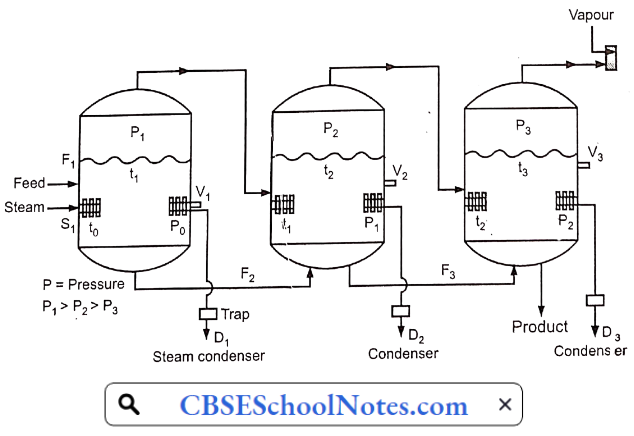
Multiple Effect Evaporation Working:
In the beginning, the multiple-effect evaporator is at room temperature and atmospheric pressure.
Liquid feed is introduced in all the 3 evaporators and the following operations are performed:
- Vent valves v1, v2, v3 are open and other valves are closed.
- A vacuum is created in liquid chambers.
- Steam valve si and condensate valve Di are opened. Steam is supplied. Steam’ initially replaces cold air in the steam space of the first evaporator. When air is removed valve V1 is closed.
- Steam is supplied till pressure P0 steam is created in steam space so that the temperature of the steam is t0.
- Steam gives its temperature to liquid feed in the first evaporator and gets condensed.
- Condensate is removed through valve D1.
- Liquid temperature increases and reaches boiling point ti, and vapour is generated exerting pressure p1.
- This vapour displaces air in the upper part of the first evaporator and the steam space of the second evaporator.
- After the air is completely displaced from the steam space of the second evaporator, valve v2 is closed.
- Vapour transmits heat t1 to liquid in the second evaporator and gets condensed.
- Condensate is removed through valve D2. Similar steps are continued in 3rd evaporator.
The steam to the first evaporator is at temperature t0 and pressure po. Feed is initially at room temperature. Steam gives its heat to feed. The difference in temperature of steam and feed reduces, Therefore the rate of condensation reduces. Therefore pressure in the vapour space of the first evaporator gradually increases to Pi. Increasing temperature to ti at which liquid boils in the first evaporator. The temperature gradient now is t0– t1.
The vapour from the first evaporator is now at a temperature ti and cannot boil the liquid in.
- For the second evaporator if its boiling point remains t1 there will be no temperature gradient.
- In such case vacuum is drawn in the first evaporator so that liquid boils at t2 and t2 < t2 so that the temperature gradient: of t1– t2 is maintained.
- The vapour in the first evaporator exerts pressure at P2. Similar is the case with the third evaporator.
- As toiling proceeds liquid level in the first evaporator goes down. Feed is introduced through.
- The eed valve to maintain the liquid level constant. Similarly, feed is supplied to second and third-effect evaporators through valves F2 and F3.
- When the liquid in all three 3 evaporators is sufficiently concentrated, product valves are opened to collect the thick liquid.
- There is a continuous supply of steam and feed and a continuous withdrawal of products. The evaporator works continuously.
Multiple Effect Evaporation Uses:
- Vertical tube evaporator or short tube evaporator is used in the manufacture of the cascara extract.
- Vertical tube evaporator or short tube evaporator is used in the manufacture of salts
and caustic soda.
Multiple Effect Evaporation Advantages:
- It is suitable for large-scale and continuous operation.
- It is highly economical when compared with a single effect.
- About 5 evaporators can be attached.
Economy of multiple effect evaporator:
The economy of the evaporator is the quantity of vapour produced per unit of steam admitted. It is calculated by considering the following assumptions. Feed is admitted at its boiling point. Therefore it does not require more heat to raise its temperature. Hence, the supplied steam gets condensed to give heat of condensation. This heat is then transferred to the liquid. The heat transferred now serves as latent heat of vapourization, i.e. Liquid undergoes vapourization by receiving heat. Loss of heat by any means is negligible.
The economy of the evaporator may be expressed as:
⇒ Economy of evaporator = Total mass of vapour produced/ Total mass of stem supplied
In a single effect, the evaporator stem is produced only once. Hence
⇒ The economy of a single effect evaporator = N units of vapour produced / N units of stem supplied = 1
In a multiple-effect evaporator, one unit of steam produces vapour many times, depending on the number of evaporators connected. Hence,
⇒ The economy of a multiple effect evaporator = N units of vapour produced/ 1 unit of stem supplied Not
So, the economy of the multiple effect evaporators is equal to the number of units connected multiplied by the economy of the single evaporator
Evaporation In Pharmaceutical Engineering Multiple-Choice Questions
Question 1. Which operation is generally carried out after evaporation?
- Distillation
- Crystallization
- Extraction
- Drying
Answer: 4. Drying
Question 2. Which condition should liquid fulfil to undergo the evaporation process?
- Liquid should be volatile
- Liquid should be viscous
- Solent should not be volatile
- Constituents must be heat-sensitive
Answer: 1. Liquid should be volatile
Question 3. What is the purpose of the entrainment separator in the climbing film evaporator?
- Allowing the heat to transfer
- Breaking the foam
- Allowing the vapour to escape
- Pulling the liquid up
Answer: 2. Breaking the foam
Question 4. Calendario consist of the number of
- Baffles
- Tubular surface
- Outlets
- Jackets
Answer: 2. Tubular surface
Question 5. What is the problem one can face during evaporation in climbing film evaporators?
- Film formation
- Droplet formation
- Entrainment of liquid
- The boiling point of liquid
Answer: 3. Entrainment of liquid
Question 6. Which evaporator gives the porous final product after evaporation?
- Vacuum evaporator
- Multiple effect evaporators
- Pan Evaporator
- Climbing film evaporator
Answer: 4. Climbing film evaporator
Question 7. Evaporation is carried out in which one of the following conditions?
- At the boiling temperature
- Room temperature
- Above the boiling temperature
- Below the boiling temperature
Answer: 3. Above the boiling temperature
Question 8. Which one of the following factors does not affect the evaporator?
- Melting point of solids
- The boiling point of liquids
- Viscosity of liquid
- Surface area of the evaporator
Answer: 1. Melting point of solids
Question 9. A triple-effect evaporator uses the concept of one of the following evaporators?
- Vertical tube evaporator
- Pan evaporator
- Climbing film evaporator
- Vacuum evaporator
Answer: 1. Vertical tube evaporator
Question 10. Feed is preheated in one of the following evaporators?
- Climbing film evaporator
- Pan evaporator
- Vacuum evaporator
- Forced circulation evaporator
Answer: 1. Climbing film evaporator
